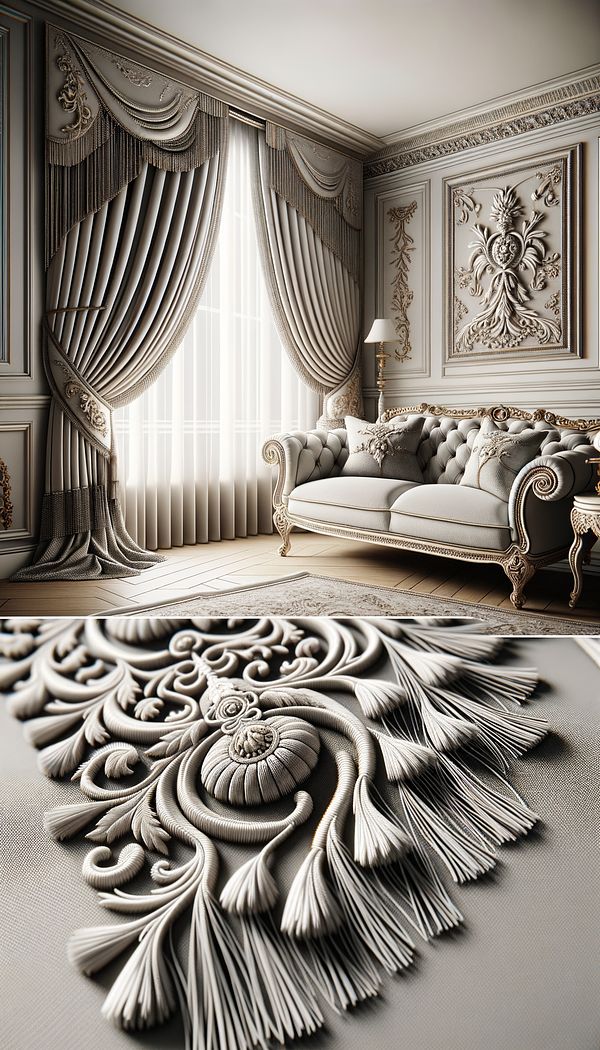What is Passementerie?
Passementerie is the art of making elaborate trimmings or edgings of applied braid, gold or silver cord, embroidery, colored silk, or beads for clothing or furnishings.
Description
Passementerie is a decorative craft that has been cherished in the realm of interior design for centuries. Originating from the French word for 'trimming', this technique encompasses a wide range of decorative embellishments including tassels, fringes, braids, cords, and more, made from various materials such as silk, wool, and metallic threads. Its versatility allows it to add depth, texture, and ornamental beauty to both fabric and furniture, making it a beloved choice for enhancing the aesthetics of interior spaces.
From opulent curtains to luxurious upholstery, passementerie offers a way to infuse spaces with a layer of sophistication and style. It has found its place in various design styles, from the grandeur of the Baroque and Rococo periods to the more restrained elegance of contemporary designs. This craft demands a high level of skill and creativity as artisans meticulously create patterns and designs that can elevate the ordinary to the extraordinary.
In today's interior design landscape, passementerie has evolved yet remains rooted in its traditional applications. Designers incorporate it in modern contexts, blending historical craftsmanship with contemporary aesthetics. It serves not only as a nod to the grandeur of the past but also as a bridge to contemporary design sensibilities, proving that traditional crafts can still have a significant role in modern interior decoration.
Usage
Passementerie is commonly used to add decorative elements to various home furnishings, such as on the edges of curtains and draperies, as trimming on upholstered furniture, and even on accent pillows and lampshades. In luxury interiors, passementerie can be found adorning the edges of tablecloths, bedspreads, and valances, adding a touch of elegance and richness to the overall décor.
FAQs
-
Is passementerie limited to a specific design style?
No, passementerie is versatile and can be incorporated into many different design styles. From historical periods like Baroque and Rococo to contemporary and minimalist designs, its wide range of applications allows it to fit seamlessly into various interior decor trends.
-
Can passementerie be used in modern interiors?
Absolutely! While traditionally associated with more ornate and luxurious settings, passementerie can also be used in modern interiors. Contemporary designers often use subtler forms of passementerie, like simple braids or cords, to add texture and detail without overwhelming the space.
-
How is passementerie made?
Passementerie is crafted by skilled artisans who use techniques such as braiding, twisting, and weaving to create detailed trimmings and decorations. These artisans work with a variety of materials, including silk, wool, and metallic threads, to produce the intricate designs characteristic of passementerie.
-
Is passementerie expensive?
The cost of passementerie can vary widely based on the materials used, the complexity of the design, and the artisan's skill level. Some high-end passementerie pieces, especially those made with luxury materials or requiring intricate craftsmanship, can be quite expensive.
Practical Application
When incorporating passementerie into your design, consider the overall style and feel of the space. Use it as a tool to add depth, texture, and ornamental elegance to items like curtains, upholstery, and decorative pillows. Start with smaller elements to introduce passementerie into modern or minimalist interiors, ensuring it complements rather than overwhelms the decor. Remember, the key is in the details; even a simple braid or cord can significantly elevate the appeal of a piece.
-
Design Styles478 articles
-
Decorative Techniques322 articles
-
Textile Techniques10 articles
-
Materials & Textiles360 articles
-
Textiles & Upholstery252 articles
-
HarmonyHarmony is the aesthetic concord and pleasing coherence among various elements in a design.
-
Tudor RoseA traditional floral symbol of England, often used in architecture and design.
-
VintageVintage refers to items, especially furniture and decor, from a previous era that have a sense of history and timeless appeal.
-
CRI - Colour Rendering IndexCRI is a scale from 0 to 100 percent measuring a light source's ability to reveal the colors of various objects faithfully in comparison with a natural light source.
-
Cushion DrawerA cushion drawer is a drawer that features a built-in cushion or pad, enhancing comfort and functionality.
